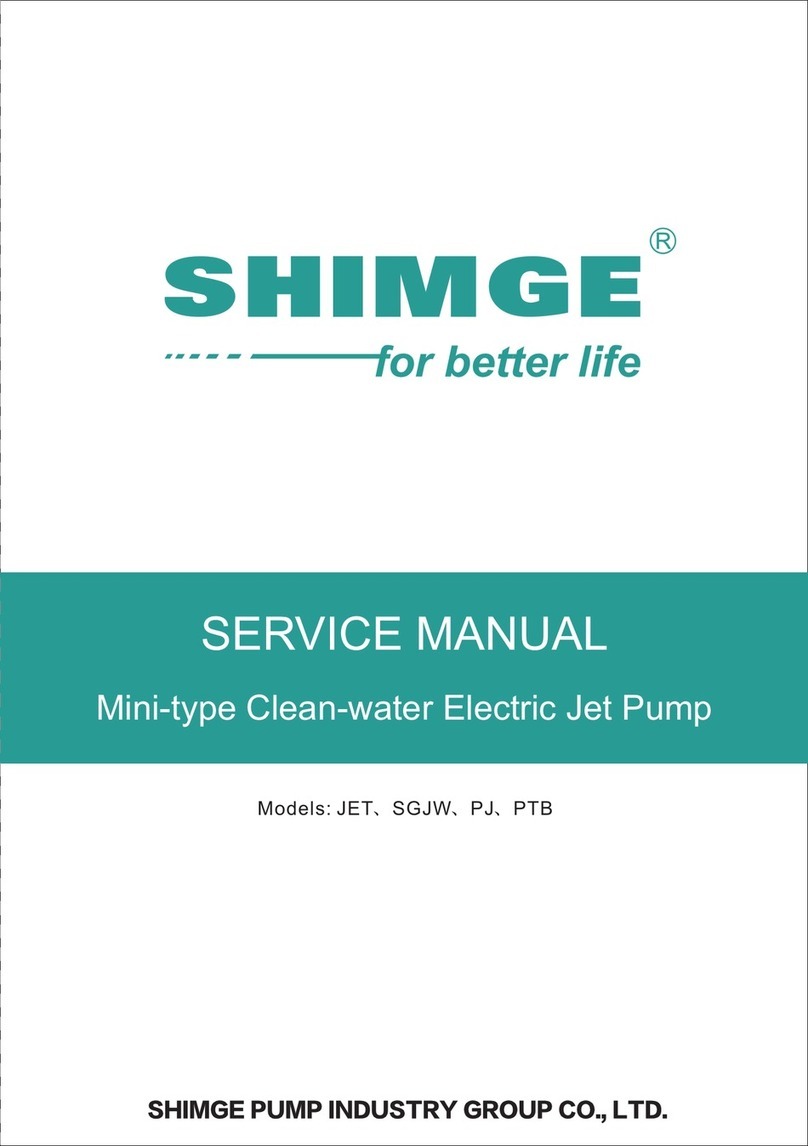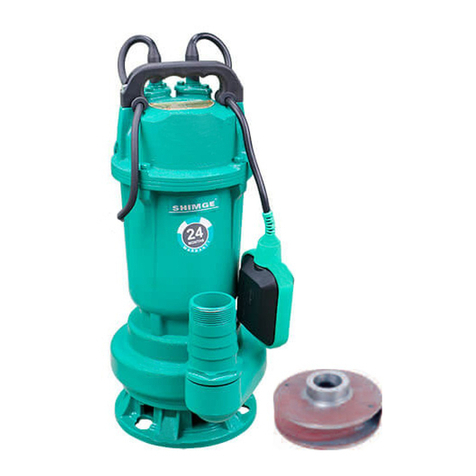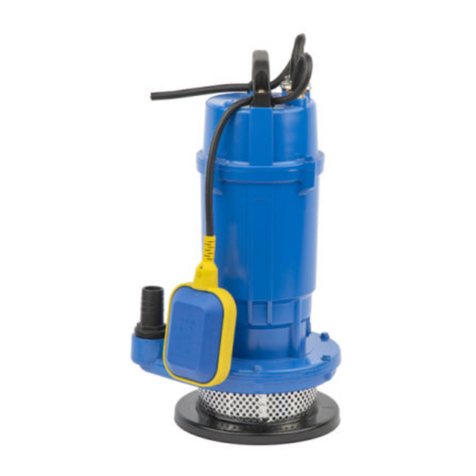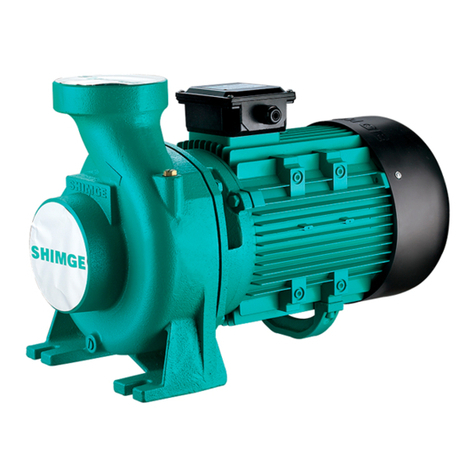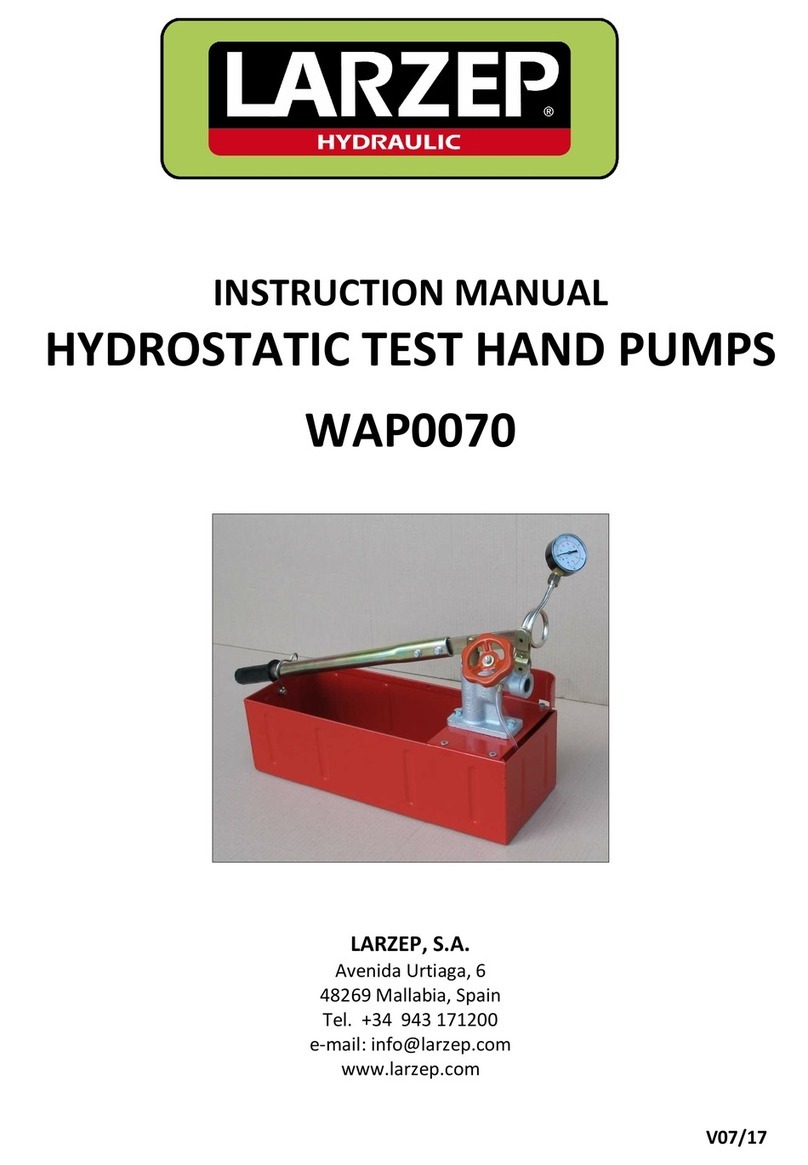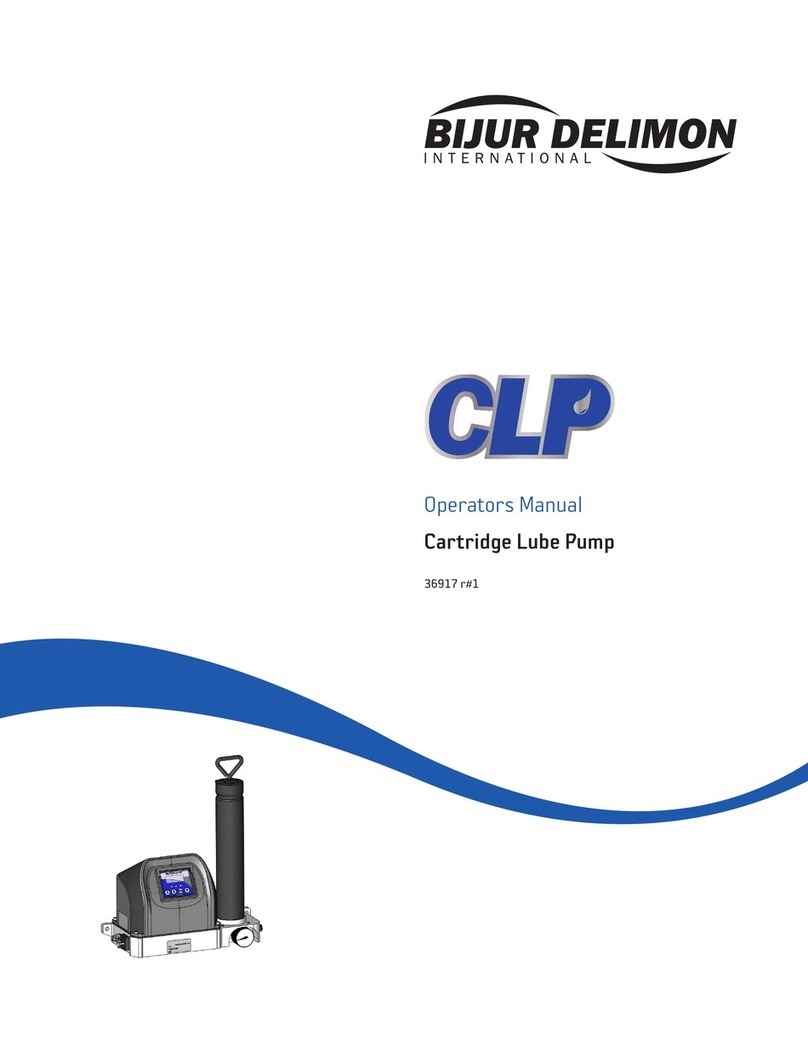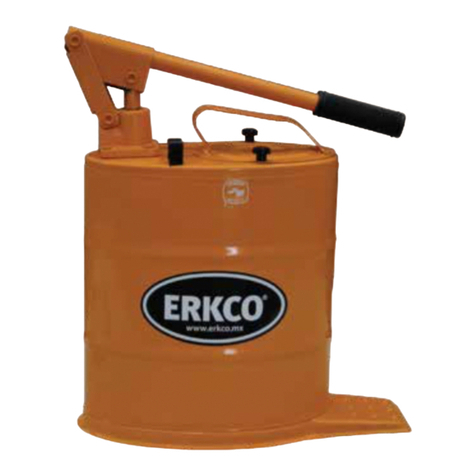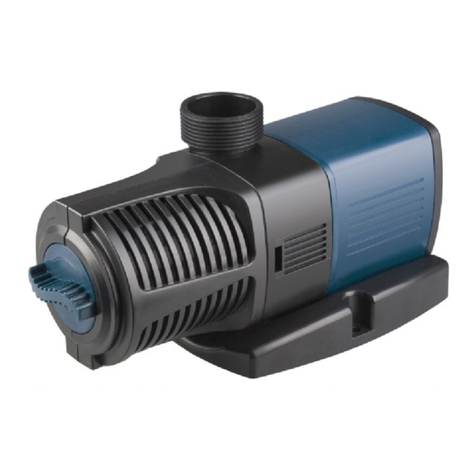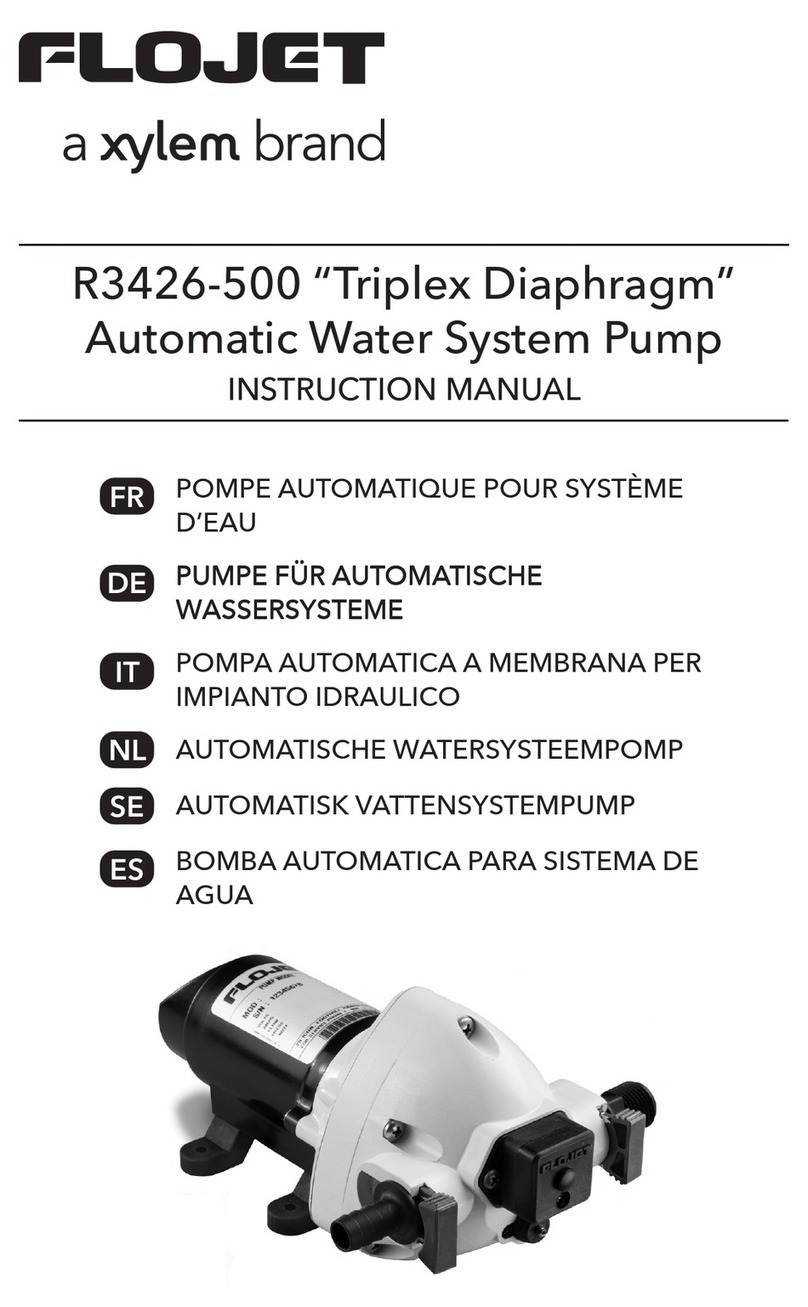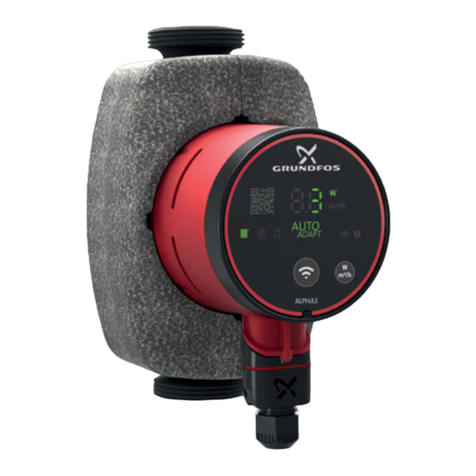SHIMGE QGYD User manual

Models: QGY(D)
Oil-filled Submersible Screw Pump
SERVICE MANUAL

I. Product Introduction
II. Operating Conditions
III. Structure Diagram
IV. Instructions for Installation and Use
V. Maintenance
VI. Troubleshooting
Contents

Thank you very much for choosing our products, and please read over the Operating Manual and
keep it properly before the installation and use.
Warning
• The Electric Pump must be grounded reliably before use, and shall be equipped with
an electrical leakage protection device;
• It's strictly prohibited to touch the Electric Pump during operation;
• It's strictly prohibited to run the Electric Pump without water;
• It's strictly prohibited to run the Electric Pump with the valve closed;
• For three phase-motors with integrated thermal protector shut down due to overload
or overheating, it is NOT allowed to re-connect the power until motor cooling for more
than 10 minutes.
I. Product Introduction
A QGY(D) oil-filled electric submersible screw pump (hereinafter referred to the “Electric
Pump”) is composed of two parts :pump set and motor. Pump set is lying upper of the Electric
pump, the main components are screw and rubber stator, which constitute an internally-engaged
sealed-rotor positive displacement pump with the operating principle of driving the screw via the
universal joint to make a rotational planet motion around the rubber stator with the eccentric
distance e as radius. A single-phase or three-phase asynchronous motor is at the bottom of the
Electric pump, adopting single-ended mechanical seal as dynamic seal in the motor, and at the
place of sealing of each fixed spigot is an O-shaped rubber seal ring used as the static seal.
The Electric Pump of this series, with no limit of minimum head, is able to operate as long as
above max head, its features like high head, high efficiency and wide high efficiency area make it
widely used in long-distance farm irrigation, spray irrigation, garden irrigation, deep well water
lifting, tower water delivery,, water supply and drainage for breeding industry, and efficient
oxygenation application, etc.
II. Operating Conditions
The Electric Pump shall be able to operate continuously and normally in the following
operating conditions:
1. The temperature of the medium does not exceed 40°C;
2. The pH value of the medium is 6.5~8.5;
3. The mass ratio of the solid impurities contained is not more than 3%, the particle size is
not bigger than 0.2mm, and the fiber length is not more than 0.3 time the screw pitch of the
rotator;
4. The maximum submersible depth of the Electric Pump is not more than 70m, while the
minimum depth is 0.5m.

1 Lifting bolt
III. Structure diagram
2 Cap nut
3 Flat washer
4 Discharge chamber
5 Sand insulating sleeve
6 Rubber stator
7 Cable jacket
8 Cover plate
9 Water absorption
chamber
10 Mesh enclosure
11 Screw
12 Cable
13 Stud
14 Slotted cheese-head
screw
15 Oring
16 Sand throwing sleeve
17 Sand prevention
cushion
26 Deep groove ball
bearing
25 Flat washer
24 Mechanical seal
23 Oring
22 Round-hole rubber
jacket
21 Oil chamber
19 Cross recessed
countersunk head screw
20 Diamond-shaped
press plate
18 Sand prevention seat
27 Rotor

28 Shoulder ring
29 Deep groove ball
bearing
30 Upper retaining sleeve
31 Stator core with
winding sleeve
32 Bearing block
33 Cross recessed
countersunk head screw
34 Locating bush
35 Motor bracket
36 Capacitor (single
phase)
37 Regulating
membrane
38 Bottom cover
39 Retaining ring

MΩMΩ
Cold insulation resistance of the Electric Pump ≥50MΩ
0
25
50
75
100
0
25
50
75
100
Yellow-green line
AC 380V
~
Protection Device Wiring Diagram
Input
A B C A B C
IV. Instructions for Installation and Use
1. Before installation and use, please fully check whether the safety or performance of the
Electric Pump is affected or damaged during transportation or storage, for example, whether any
cable or plug is in a perfect condition. In case of any damage, please have a specialized person
making replacement or repair.
2. Before the Electric Pump operates, please completely inspect the insulation resistance of
the Electric Pump, of which the cold insulation resistance shall not be less than 50MΩ.
3. During wiring, please correctly install an electrical leakage protection device (Suppose the
device does not come with the pump, user should buy it by himself ) to the Electric Pump. In case
that the Electric Pump is a three-phase one, please draw the yellow-green line with the grounding
symbol, out of the cable involved, and ground this line reliably. Carry out the wiring as shown in
the following diagram. Ground in a reliable way the patch panel to be used with the Electric Pump
which is provided with a plug upon delivery.
Output
Fuse
Pump

The pump set shall be
completely submerged
in water.
4. Before putting the Electric Pump into water, please do a test run. Do not perform dry
running without water. Place the Electric Pump horizontally in a ditch or tank (bucket) (make sure
that the pump set is submerged in water) and check whether the Electric Pump works normally
and whether the rotational direction of the pump is the same as that of the indicating arrow. When
finding any reverse rotation of a three-phase electric pump (no water will be pumped upwards
when a three-phase electric pump operates reversely), please cut off the power supply and
exchange any two phases of the three-phase pump, or otherwise the rubber stator will be worn
out.
After power-on, there is
water flowing out of the
outlet.
5. Connect a delivery pipe (whose specifications are selected based on Table 1) matching
with the discharge chamber. For example, tighten a soft delivery pipe with the iron wire or clamp
or reliably connect a steel-type delivery pipe with the screwed joint, and then put a rope through
the lifting ring and tie it down for the purpose of lifting and placing.
6. Do not strike or press the cable or use it as a lifting rope. When the Electric Pump is
operating, do not arbitrarily pull the cable, so as to prevent the cable from being damaged
and causing any electric shock accident.

>5m
>5m ≤70m
The submersion depth shall not
exceed 70m.
7. When the Electric Pump is submerged in water, its depth shall not exceed 70m and shall
be at least 5m, and it shall not be caught in sludge. Simultaneously keep the mesh enclosure or
the inlet from being blocked by water plants or sundries, for such blocking may result in the
Electric Pump's failure to operate normally. During operation, please frequently check the water
level and do not make the operating Electric Pump appear above the water surface.
The Electric Pump shall not
appear above the water
surface.
The Electric Pump shall not
be caught in sludge.
8. When the Electric Pump to be used is far away from the power supply, cable should be
thickened according to the distance(the diameter of the cable line shall be bigger than that of the
Electric Pump)
9. Please arrange a safety warning sign on the site where the Electric Pump is operating,
which reads “DANGER: ELECTRIC SHOCK RISK AND NO ENTRY FOR PEOPLE OR
ANIMAL”, so as to prevent any accident.

30m
DANGER: ELECTRIC
SHOCK RISK AND
NO ENTRY FOR
PEOPLE OR ANIMAL
10. A single-phase electric pump with integrated automatically-reset thermal protector, when
the thermal protector works, automatic reset will happen after the temperature of the motor
decreases to a certain value, In the event of frequent protection actions, please cut off the power
supply and find out the causes and then operate the Electric Pump until the relevant trouble is
cleared.
For a three-phase electric pump with integrated power failure-reset thermal protector, upon
the protection action of the protector, please first cut off the power supply and turn on the power
supply again after 10 minutes, Electric Pump will operate normally. In the event of frequent
protection actions, please cut off the power supply and find out the causes and then use the
Electric Pump until the relevant trouble is cleared.
11. This series is filled with No. 10 white food machinery oil so as to ensure that the
mechanical seal is effectively lubricated and cooled, which might leak in case of any damage or
fault of the Electric Pump. The leaked white oil might damage the botany planted or the animal
bred or pollute the drinking water or food involved in any application relating to planting, breeding,
or delivery or processing of drinking water or food. To select this product, the user shall evaluate
the relevant application and the consequence of the use of this product so as to confirm whether
this product is suitable and even invite a related specialized person to do such confirmation when
necessary. In case of any leakage of white oil, please immediately stop using and properly dealing
with it.
12. When the content of solids in the medium pumped exceeds the specified one, the flow
rate of the Electric Pump will obviously decline, the screw and the rubber stator shall be replaced
in time if such dramatic decline continues, make sure that the screw properly fits with the rubber
stator.
13. When the Electric Pump is being used, please first cut off the power supply in case that
the Electric Pump is to be relocated or touched, so as to avoid any accident.

≥60mm
①
②③
At least 10 times as the diameter of the conductor.
To touch the Electric Pump, please cut off
the power supply first.
14. When the Electric Pump is operating, its cable head or plug board shall not be put into
water; when such submersion is necessary due to the addition of a cable, the connection shall be
sealed strictly to prevent water seepage and electrical leakage. pply in case that the Electric
Pump is to be relocated or touched, so as to avoid any accident.
1.Remove the insulating layer
without damaging the conductor.
2.Stagger long and short wires.
3.Ensure that no oil, water or any
oth er polluta nt ex ist at th e
connection.
1.Divide each connector into
several strands evenly (no less
than 6 ones) and tighten them.
2.Cross the two connectors so that
the overlapping length will make
the two ends aligned with the
insulating layer.
1.Clench each strand. First get one strand from
the middle and make it wind to one end (the
wound core wire shall include the remaining
strands) and then make each of the remaining
strands wind successively as well.
2.Follow the same procedure at the other end.
3.Use plier to tighten the connectors. The best
effects can be achieved by wrapping the
connectors with tin.
4.Remark: For other methods, please refer to the
attached Drawing 1 and Drawing 2.
30mm
④
Plastic insulating tape
10mm
30mm
⑤
1.First use the black tape to tightly wrap the connector area and
make two layers; do not expose copper wire head. Please see the
attached Drawing 3.
2.Then use the pressure sensitive tape (self-adhesive tape) to
make a three-layer wrapping, 10mm longer at the two ends should
be needed based on previous layer wrapping. Do not do wrapping
until the length of the tape drawn out is twice the original length.
3.Finally apply the plastic insulating tape (yellow transparent) to
make the last layer wrapping.
1.Properly arrange the connectors of core wires and
make a four-layer wrapping by use of the pressure
sensitive tape with two ends wrapping a length of 30mm
on the cable sheath and 10mm longer at the two ends
should be needed based on previous layer wrapping
2.Then make a three-layer wrapping with the plastic
insulating tape with the next layer about 10mm longer
than the first layer at the two ends.
Pressure sensitive tape
Plastic insulating
tape Pressure sensitive tape
Black tape Connector of
several wires
First layer
Last layer
Cable Connection Diagram
Drawing 1
An electric arc welded joint is
preferred.
Drawing 2 Drawing 3
A joint made by cold welding of casing
is also acceptable.
When the first layer of the black tape is made,
no copper wire shall be exposed or the tape
shall not be punctured.

15. Do not lift the Electric Pump out of water immediately after the power supply of the
Electric Pump is cut off, so as to ensure safety.
V. Maintenance
1. The matters needing attention prior to the disassembly of the motor for maintenance: First
wait until the motor is cool, then unscrew the oil filler bole, to release the high-pressure gas
generated inside due to burn-in, for the purpose of preventing the upper cover from jumping out to
hurt people.
2. Regularly inspect the insulation resistance between the motor bracket and the winding of
the Electric Pump, which shall be greater than 1MΩ when the operating temperature is nearly
achieved, or otherwise usage shall not be allowed until the relevant inspection and maintenance is
completed.
3. After 2000-hours normal usage of the Electric Pump, the Electric Pump shall be
maintained as per the steps below:
Disassemble the Electric Pump and inspect various easy broken parts such as the roller
bearing, mechanical seal, screw, and rubber stator. Please immediately replace those in case
there are damaged ones.
After 2000-hour operation,
please inspect quick-wear parts.
Screw
Rubber stator
Mechanical seal
Bearing
Screw
0
0.2
0.1
0.3
0.4
0.5
0.6
MPa
0
0.2
0.1
0.3
0.4
0.5
0.6
MPa
Air pressure test:
After disassembly is
done for repairing or
replacing mechanic
seal, an air pressure
test shall be carried
out under the testing
pressure of 0.2 MPa
for 3 minutes, there
is no phenomenon
of leakage or
sweating.
Rubber stator
Bearing
Mechanical seal
Air pressure test: After disassembly is done for repairing or replacing mechanic seal, an air
pressure test shall be carried out under the testing pressure of 0.2 MPa for 3 minutes, there is no
phenomenon of leakage or sweating.

Fault
VI. Troubleshooting
Cause Remedy
Difficulty
in startup
1. The supply voltage is too low.
2. The Pump suffers a phase loss.
3. The screw is blocked.
4. The voltage drop of the cable is
too high.
5.The stator winding is burnt.
1. Adjust the voltage to ±10% of the rated value.
2. Inspect the plug, the cable, and the head of the
outgoing line of the switch.
3. Correct the part blocked.
4. Use a thickened cable.
5.Re-insert the winding or carry out overhaul.
Low
water
yield
1. The mesh enclosure is blocked.
2. The screw or rubber stator is
seriously worn.
3. The submersion depth of the
Electric Pump is less than
standard and air is absorbed.
4.The screw rotates reversely.
1. Clear away sundries like water plants.
2. Replace the screw or rubber stator.
3. Adjust the submersion depth of the Electric
Pump, which shall not be less than 0.5m.
4.Exchange any two phases of a three-phase
electric pump.
No flow
suddenly
1. The switch is disconnected or
the fuse is burnt.
2. The power supply is cut off.
3. The screw is blocked.
4. The stator winding is burnt.
5. The protector trips.
6. The outlet pipe falls off.
7.The impact by backwater exists
in the pipeline and the screw gets
loose.
1. Inspect whether the head range or the voltage
of the power supply conforms to the relevant
provisions and make adjustments.
2. Find out the cause of power failure and clear
the relevant fault.
3. Clear away sundries.
4. Re-insert the winding or carry out overhaul.
5. Find out the relevant cause (too low supply
voltage, overload, or blocked screw) and remove
the fault.
6. Re-connect the pipeline.
7.Disassemble the Electric Pump and re-tighten
the screw, and add a check valve to the pipeline.
Stator
winding
burnt
1. The Electric Pump suffers from
a phase loss and operates for a
long time.
2. Water leakage occurs due to the
damaged mechanical seal,
causing the interturn or interphase
short circuit.
3. The screw is blocked.
4. The Electric Pump start
frequently or operates without
water for a long time.
5.The Electric Pump makes
overload operation.
Disassemble the winding and re-insert the
winding as per the concerned technical
requirements as well as immerse and dry the
insulating varnish or deliver the winding to the
repair station for repair.
Notes:
1. All the diagrams in this Operating Manual shall be only for reference, the Electric Pump
purchased and its accessories might be different from those indicated in this Operating Manual.
Your understanding is really appreciated.
2. This series of products is subject to continuous improvements and changes without further
notice and a product (including its appearance and color) in kind shall prevail.
This manual suits for next models
1
Table of contents
Other SHIMGE Water Pump manuals
Popular Water Pump manuals by other brands

Polygroup
Polygroup SFX600 user guide
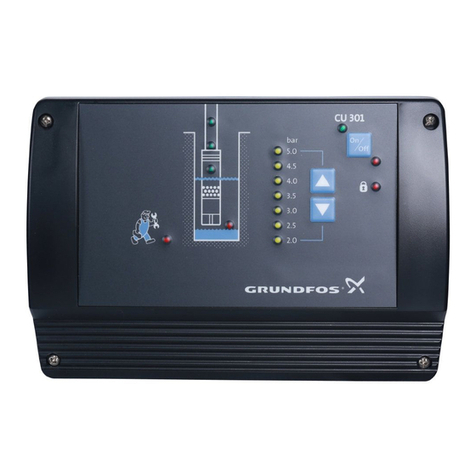
Grundfos
Grundfos CU 301 Installer manual

Stuart Turner
Stuart Turner AQUABOOST iBolt Pump Installation, operation & maintenance instructions

Desmi
Desmi NSA Series Operation and maintenance instructions

Kripsol
Kripsol S2-025M owner's manual
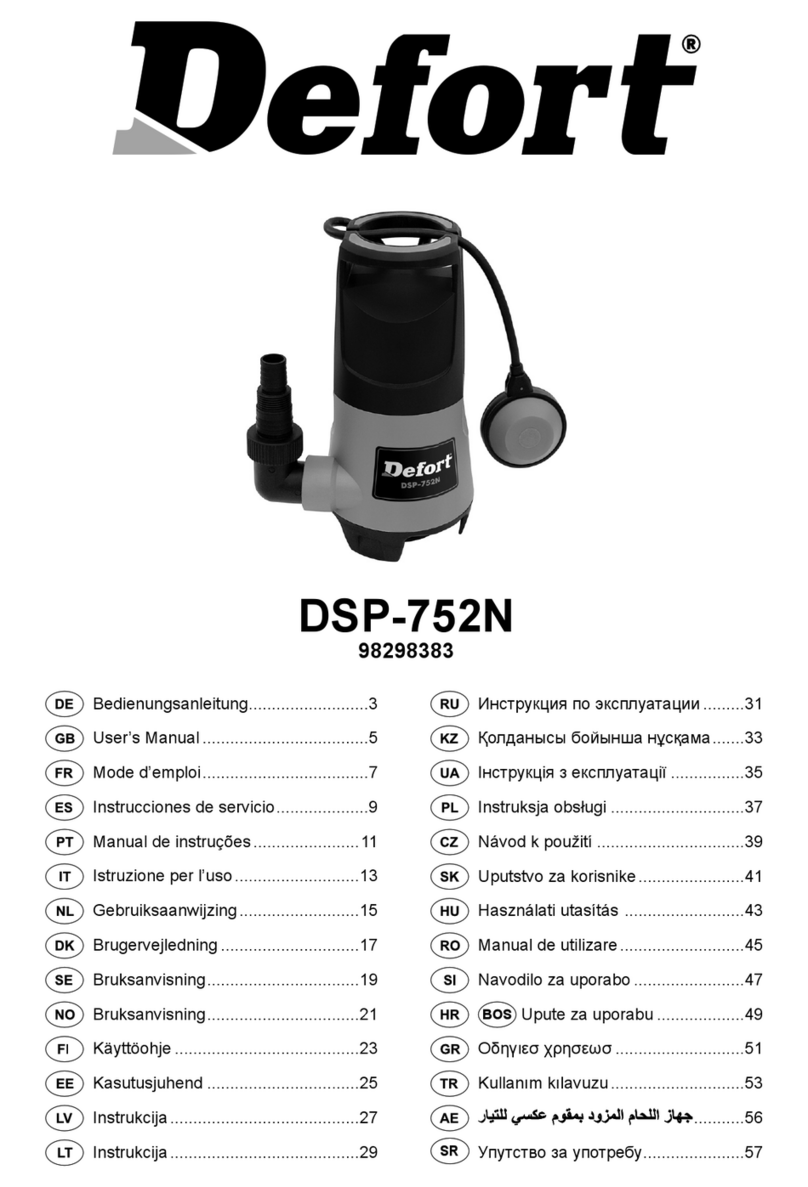
Defort
Defort DSP-752N user manual
